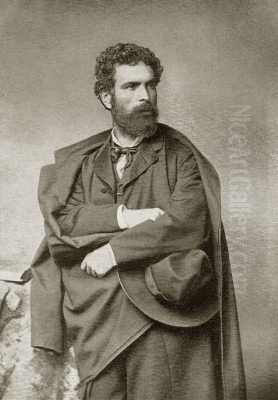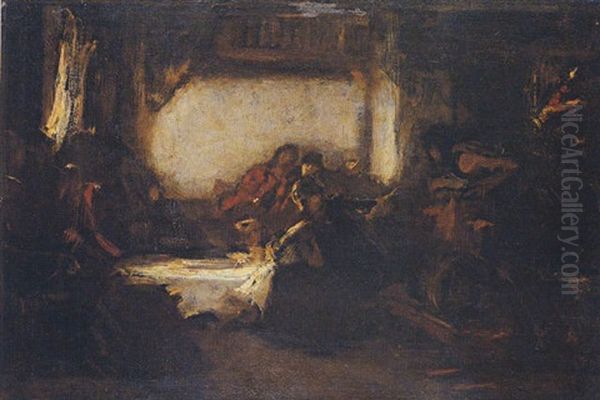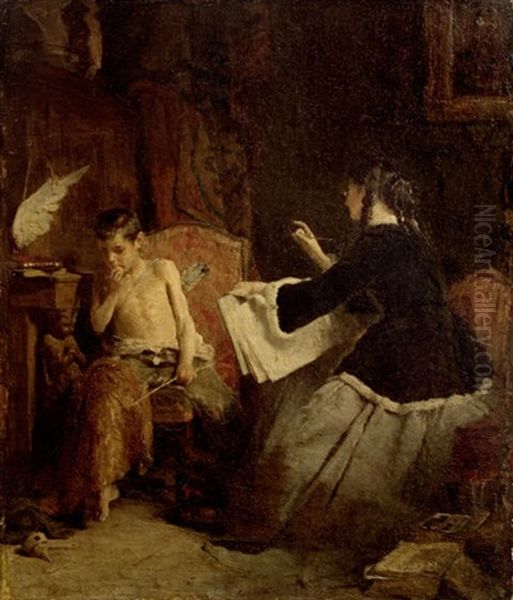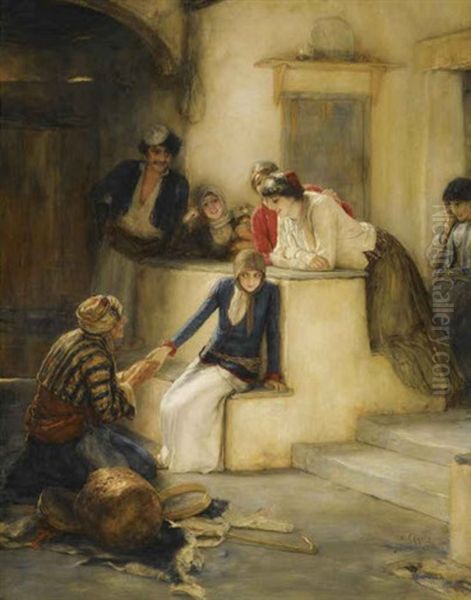
Nikolaos Gyzis stands as a towering figure in the landscape of 19th-century European art. A Greek painter whose life and career unfolded primarily in Munich, Germany, he became a pivotal artist of the renowned Munich School, while simultaneously remaining deeply connected to his Hellenic roots. His work, characterized by technical brilliance, emotional depth, and a fascinating evolution of style, bridges the academic traditions of Germany with the burgeoning national identity of modern Greece. This exploration delves into the life, art, and enduring legacy of a painter who masterfully navigated the cultural currents of his time.
Early Life and Artistic Awakening in Greece
Nikolaos Gyzis was born on March 1, 1842, in the village of Sklavochori, located on the Cycladic island of Tinos, Greece. This island origin is significant, as Tinos has a long tradition of folk art and marble carving, potentially providing an early, albeit indirect, exposure to artistic creation. His innate talent for drawing became apparent at a young age. Recognizing his potential, his family moved to Athens in 1850.
Even before formal enrollment, the young Gyzis began attending classes at the Athens School of Fine Arts (then known as the Polytechnic School) around the age of eight. He formally entered the institution as a student at twelve. For the next decade, he immersed himself in his studies, honing his skills under the guidance of Greek artists trained in the Western European academic tradition. This period laid the foundation for his technical proficiency and instilled in him the discipline required for the demanding standards of 19th-century art academies. His time in Athens exposed him to the nascent artistic identity of the newly independent Greek state, an identity often looking towards classical antiquity and the recent War of Independence for inspiration.
The Munich Scholarship: A Gateway to Europe

Gyzis's exceptional talent did not go unnoticed. In 1865, upon graduating from the Athens School of Fine Arts, he was awarded a prestigious scholarship, enabling him to pursue further studies abroad. Like many aspiring Greek artists of his generation, his destination was Munich, the capital of Bavaria. The city's Academy of Fine Arts (Akademie der Bildenden Künste München) was, at the time, one of the most respected and influential art institutions in Europe, attracting students from across the continent and beyond.
His arrival in Munich marked a turning point. He enrolled in the Academy, where he studied under prominent figures of the German art scene. Among his most influential teachers was Karl von Piloty, a leading exponent of historical painting known for his dramatic compositions and meticulous detail. Piloty's tutelage profoundly shaped Gyzis's approach to large-scale historical and allegorical subjects. Gyzis quickly absorbed the technical rigour and thematic concerns prevalent in Munich, distinguishing himself among his peers.
Integration into the Munich School
Munich in the latter half of the 19th century was a vibrant artistic hub. The "Munich School" is the term used to describe the style and the artists associated with the Academy during this period. It was characterized by a strong emphasis on academic draftsmanship, a rich, often dark colour palette influenced by Dutch Golden Age masters like Rembrandt, and a preference for historical subjects, portraiture, and genre scenes (scenes of everyday life). While rooted in academicism, it also incorporated elements of Realism and, later, influences from Symbolism.
Gyzis became one of the foremost representatives of the Munich School, particularly among the significant contingent of Greek artists studying and working there. He formed a close, lifelong friendship with fellow Greek painter Nikiforos Lytras, who had also come to Munich to study. Together, they navigated the German art world, supporting each other while developing their distinct artistic voices. Gyzis fully embraced the technical standards of Munich, mastering the depiction of textures, light, and human anatomy with remarkable skill.
His integration was so successful that he eventually chose to settle permanently in Munich, making it his home and primary center of artistic production for the rest of his life. Despite living abroad, his connection to Greece remained a vital source of inspiration, informing many of his most celebrated works. He became a bridge figure, embodying the synthesis of German academic training and Greek cultural identity.
Artistic Style: From Realism to Symbolism

Gyzis's artistic journey was marked by a gradual evolution in style and subject matter. His early works, created during his studies and the years immediately following, are largely aligned with the genre painting popular within the Munich School. These pieces often depict scenes from everyday Greek life, rendered with ethnographic detail and a warm, empathetic eye. He captured the customs, costumes, and character of his homeland with precision and sensitivity.
His style during this period combined the meticulous realism learned in Munich with a certain romantic sensibility. He excelled at narrative clarity and psychological insight, bringing his figures to life. Works like The Engagement (also known as Children's Engagement) exemplify this phase, showcasing his ability to portray tender human interactions within a carefully constructed, detailed setting. This painting, depicting a traditional betrothal custom, was lauded for its charm and technical finesse and came to be seen as an idealized representation of Greek family life.
As his career progressed, Gyzis moved beyond straightforward genre scenes. He tackled complex historical and allegorical themes, often drawing upon Greek history, mythology, and the struggles for independence. His palette sometimes brightened, and his compositions became more dynamic, reflecting influences from Romanticism and his engagement with large-scale historical painting under Piloty.
In his later years, particularly from the 1890s until his death, Gyzis's work took a distinct turn towards Symbolism and Idealism. His paintings became more allegorical, spiritual, and introspective. Forms became softer, colours more ethereal, and the emphasis shifted from external reality to internal states of being, dreams, and abstract concepts like glory, history, and faith. This late phase reveals a more personal, philosophical dimension to his art, exploring universal human experiences through a highly refined visual language.
Major Themes and Representative Masterpieces
Gyzis's oeuvre encompasses a rich variety of themes, reflecting his diverse interests and evolving style. Several key works stand out as landmarks in his career and in the history of modern Greek art.
Genre Scenes and Greek Identity:
Early works often focused on capturing the essence of Greek life. Carnival in Athens is a vibrant depiction of traditional festivities, showcasing his skill in handling complex multi-figure compositions and capturing a lively atmosphere. The Engagement (c. 1877), as mentioned, remains one of his most beloved genre paintings, celebrated for its delicate portrayal of childhood innocence and cultural tradition. These works helped shape a visual identity for modern Greece, presenting its customs and people to a wider European audience.
Historical and National Narratives:

Gyzis engaged deeply with Greek history, particularly the War of Independence (1821-1829). The News of Victory (1871), painted shortly after the Franco-Prussian War but resonating with Greek historical memory, depicts the emotional reception of significant news, showcasing his mastery of dramatic tension and human expression.
Perhaps his most famous, and controversial, historical painting is The Secret School (Το Κρυφό Σχολειό, c. 1885-86). This work depicts a monk teaching Greek children language and history in secret during the Ottoman occupation. It became an incredibly potent symbol of Greek cultural resistance and national perseverance, widely reproduced and even featured on the Greek 200 drachma banknote. However, the historical existence of such organized "secret schools" is debated among historians, making the painting a powerful piece of national mythology as much as a historical representation. Gyzis's portrayal captured the spirit of resilience cherished by Greeks.
Mythology and Allegory:
Mythological and allegorical themes provided Gyzis with avenues for exploring universal ideas and showcasing his academic training. Eros and the Painter (c. 1870s) is a charming allegorical piece reflecting on the nature of artistic inspiration, personified by the playful god of love interacting with the tools of the artist's trade. He also tackled more dramatic mythological subjects, such as Artemis and Apollo Slaying the Children of Niobe, demonstrating his ability to handle complex classical narratives with dynamism and emotional force.
Late Symbolist and Religious Works:
In his final years, Gyzis turned increasingly towards spiritual and symbolic themes. Glory (Δόξα, c. 1894-95), often associated with the destruction of Psara during the War of Independence, is a powerful allegorical work. It depicts a luminous, winged figure representing Glory ascending over the ruins and martyrs of the historical tragedy. This painting exemplifies his late style, characterized by idealized forms, ethereal light, and a profound sense of spirituality and national mourning. Another significant late work is Judith and Holofernes, where he reinterprets the biblical story with psychological intensity and symbolic weight. These later works cemented his reputation as an artist capable of profound philosophical and emotional expression.
Gyzis the Educator: Shaping the Next Generation
Gyzis's influence extended beyond his own artistic production. In 1886, he was appointed Professor at the Munich Academy of Fine Arts, a testament to his high standing in the German art world. He became an influential teacher, mentoring a generation of artists from Germany and other parts of Europe, including Greece. He was made an honorary professor in 1888 and continued teaching until his death.
Among his notable students were German artists like Ernst Oppler and Fritz Osswald, the Swiss painter Anna May-Rycher, and potentially a Slovak artist named Popescu (details are scarce). Other sources mention Ernst Oesterle and Fritz Oppenheim as pupils influenced by his style. Crucially, he also taught Greek artists who came to study in Munich, such as Georgios Jakobides, helping to transmit the Munich School's principles back to Greece, albeit often adapted by the next generation. His teaching emphasized strong drawing skills, careful observation, and compositional clarity, principles evident in his own work.
Connections and Contemporaries: A Network of Artists
Throughout his career, Gyzis interacted with numerous prominent artists, both Greek and German. His enduring friendship with Nikiforos Lytras was foundational, providing mutual support in a foreign land. In Munich, he was part of a vibrant artistic community. He studied under Karl von Piloty and was influenced by the realism and rich technique of artists like Franz von Lenbach, a leading portraitist in Munich.
He also established friendships with members of the circle around Wilhelm Leibl, a major figure in German Realism. Leibl and his associates were themselves influenced by the French Realist Gustave Courbet, known for his unidealized depictions of contemporary life. While Gyzis's art maintained a more academic and often idealized quality compared to Leibl's stark realism, the contact likely broadened his artistic horizons.
His connections extended internationally. He was aware of, and possibly interacted with, other major figures in the European art scene, such as the flamboyant Austrian painter Hans Makart, known for his opulent historical and allegorical compositions. Within the Munich scene itself, he would have been contemporary with figures like Franz Stuck, a key representative of German Symbolism, whose thematic concerns sometimes overlapped with Gyzis's later work. Among Greek contemporaries associated with the Munich School, Konstantinos Volanakis, known for his seascapes, was another significant figure, though his focus differed from Gyzis's.
Beyond the Canvas: Design and Other Ventures
While primarily celebrated as a painter, Gyzis's artistic talents extended to other fields. He was skilled in printmaking and occasionally worked in sculpture, demonstrating a versatility common among academically trained artists of his era.
A notable example of his work beyond painting is his contribution to the first modern Olympic Games held in Athens in 1896. He was commissioned to design the diplomas (certificates) awarded to the winning athletes. This prestigious commission highlights his status as a leading Greek artist of international repute. He reportedly collaborated on illustrations for the magazine Loukis Laras with Dimitrios Vikelas, the first President of the International Olympic Committee, further linking him to this seminal event in modern Greek history. His designs for the Olympics showcased his ability to blend classical motifs with contemporary sensibilities, fitting for the revival of the ancient games.
Anecdotes, Research, and Unseen Aspects
Gyzis's life and work continue to attract scholarly attention. Academic studies, such as the PhD thesis Nikolaos Gyzis’ Art by Constantinos Didakopoulos and the book Nikolaos Gyzis: Life and Work by Mariana Kallas, provide in-depth analyses of his artistic development and cultural context. These works draw upon extensive research, likely including personal documents.
The existence of private letters and numerous sketches, particularly preparatory drawings from his time at the Munich Academy, offers valuable insights into his working methods and artistic thinking. These materials reveal his meticulous planning process, his experiments with composition and form, and the evolution of his ideas from initial concept to finished painting.
The story behind The Secret School remains a fascinating anecdote, illustrating how art can intersect with national identity and historical memory, sometimes blurring the lines between documented fact and cherished myth. His involvement with the 1896 Olympics provides another interesting facet, connecting him directly to a pivotal moment in modern Greek cultural history.
Final Years and Enduring Legacy
Nikolaos Gyzis remained active as an artist and teacher until the end of his life. In his later years, he battled leukemia, which eventually led to his death in Munich on January 4, 1901, at the age of 58. He was buried in Munich's Nordfriedhof (North Cemetery), far from his native Greece but in the city that had become his home and the center of his artistic universe.
His death marked the passing of a major figure in both Greek and German art. Gyzis's legacy is multifaceted. For Greece, he is considered one of the founders of modern Greek painting. He brought the technical sophistication of European academicism to Greek subjects, elevating genre painting and historical narratives to a high art form. His work helped define a visual language for the young nation, blending European influences with distinctly Hellenic themes and sensibilities. His influence on subsequent generations of Greek artists was profound, transmitted both through his own work and through the students he taught.
In Germany, he was a respected professor and a leading member of the Munich School. His technical mastery and ability to imbue academic forms with genuine emotion earned him widespread admiration. Some contemporaries even remarked that he was "more German than the Germans" in his dedication to the craft, yet his art always retained a unique flavour derived from his Greek heritage. He demonstrated that an artist could be deeply integrated into the German art system while maintaining a powerful connection to their native culture.
His influence extends beyond national borders. His exploration of realism, historical painting, and later, symbolism, resonates with broader European art trends of the 19th century. His ability to capture subtle psychological states and his mastery of light and shadow continue to impress viewers today. His works are held in major museums in Greece (notably the National Gallery – Alexandros Soutzos Museum in Athens), Germany, and other collections worldwide.
Conclusion: A Master Across Cultures
Nikolaos Gyzis occupies a unique position in art history. He was a Greek patriot who spent most of his adult life in Germany, a master of the Munich School whose heart remained tied to the Aegean islands and Athenian streets of his youth. His art reflects this duality: the rigorous discipline of German academic training fused with the warmth, light, and historical consciousness of Greece. From detailed genre scenes to powerful historical allegories and ethereal symbolist visions, his work reveals a remarkable artistic intelligence and a profound humanity. As a painter, educator, and cultural figure, Gyzis built bridges between nations and traditions, leaving behind a rich and enduring legacy that continues to inspire and captivate.